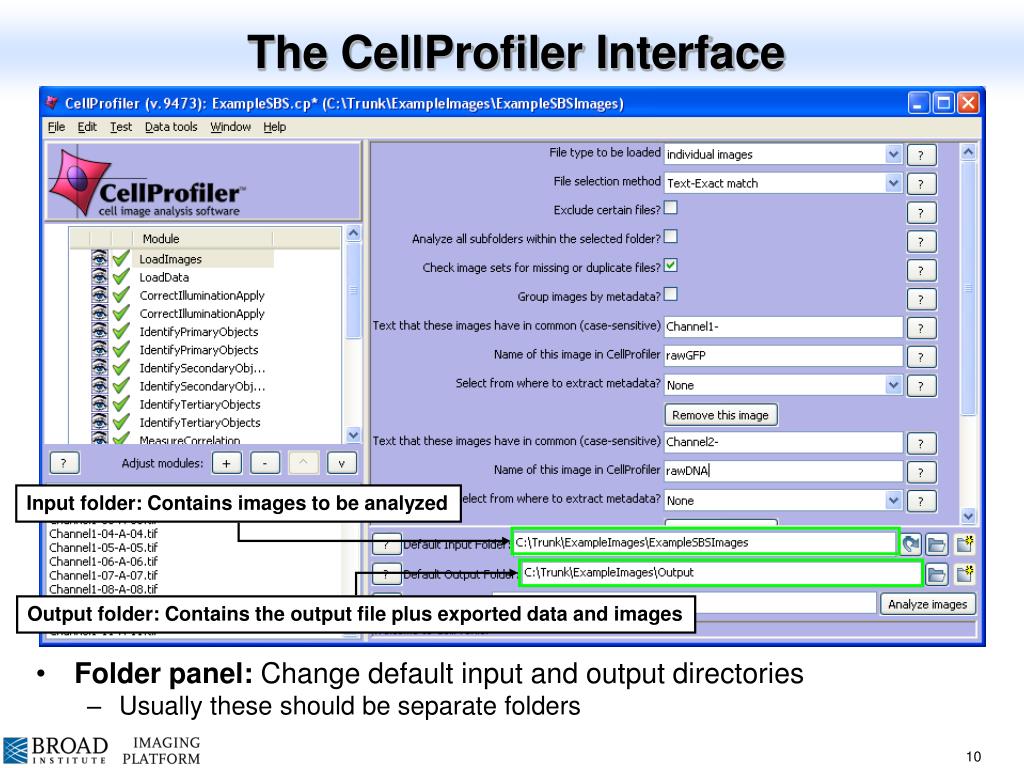
You can use the -f and -l flags to tell CellProfiler to start, or use -f for first, and last, -l to split your dataset. Now let's run with our ExampleHuman dataset!įirst of all, this CellProfiler analysis only uses one imageset, so it's not interesting, but it is informative. Make sure you can run the CellProfiler CLI by executing cellprofiler with help. Ls -lah # Should show the ExampleHuman dataset Cd to your project directory and check that your expected files are there. Now you are using the docker container as a shell. We're going to use it as a computer now.ĭocker run -it -name cellprofiler -v "$(pwd)":/project \ The ExampleHuman.cppipe is a CellProfiler pipeline, the README is the usual README, and the images are the images that we want to analyze with the CellProfiler pipeline!Įarlier I said that your docker image is a computer. Once we're there we will move onto more complex pipelines. We're going to start off with a very simple example just to get a feel for how we would run things using batch mode. Simple Analysis with the Example Human Dataset

Now we'll build our new CellProfiler image!
#CELLPROFILER BEGGINER INSTALL#
RUN apt-get update -y apt-get install -y unzip imagemagick Then create a file called Dockerfile with this: We are making these changes because the image is set up in such a way that it is very well suited for a job queue environment, but what we want here is to dig around with some exploratory analysis.Ĭreate a project directory, cellprofiler-batch-tutorial and cd into it. We will be using the default CellProfiler docker image with a few changes. Here's a quick explanation and tutorial from Ubuntu to get you started. This does not require too much Linux command line knowledge, but you will need to be able to type commands and navigate a directory structure. Quick disclaimer, if you are very uncomfortable with the command line you may want to reach out for help. Once you have it all setup you treat it just as you would a regular computer. A docker container is like a virtual machine, except without a visual interface. If you prefer to watch, here is a video where I go through the steps described.ĭocker is a way of packaging applications. Here's a tutorial of step 7, submit your batches to the cluster.
#CELLPROFILER BEGGINER HOW TO#
If you need to find a way to decrease your computational resources you can often split your dataset. The instructions for the CreateBatchFiles module describe how to set up a CellProfiler pipeline and submit it to a cluster. The larger the dataset you are analyzing the more memory it consumes. This is also an important consideration if you are running out of memory or CPU. You could split that analysis into 4 chunks, and each would complete in 15 minutes. Say you have a large dataset that would take 1 hour to complete. This is helpful when you have a very large dataset. One of the benefits of running CellProfiler in batch is that you can split your analysis. Or not so large scale analyses that you prefer to automate!
#CELLPROFILER BEGGINER SOFTWARE#
Getting to know the software is an easy task thanks to its user-friendly interface, a homepage and Youtube channel filled with valuable information for the beginner to the advanced user.This post was written by a guest author, Jillian Rowe, who can be reached at CellProfiler in batch mode is the ideal way to automate large scale analyses.

Last but not least present your data, as snapshots or a movie, guiding the viewer through your analysis and re-construction. Statistical data like volume, surface, speed, intensities, angles and many more are calculated ad hoc for you, just choose from the vast amount of available numerical data calculated in IMARIS.Īnalyse your multi-channel data set for Colocalization and even create new channels by using surfaces you created as masks. Settings used can be stored to be reviewed, refined or used in Batch applications. IMARIS will guide you through each analysis feature over the wizard tool where certain important parameter like threshold and filters can be managed. Identifications and segmentations of such structures can be done automatically or manually and even edited, sorted, grouped, exported and used for batch analysis. The IMARIS software allows you to identify, render and segment 3D-, filamentous- and point-like structures including their change and tracks over time (4D), also tracking the fate of dividing cells. Image processing allows you to enhance the quality of the image. Image reconstruction simplifies vast amounts of visual information found in 3- and 4-D data sets. Image analysis allows you to extract numerical data from your images.


 0 kommentar(er)
0 kommentar(er)
